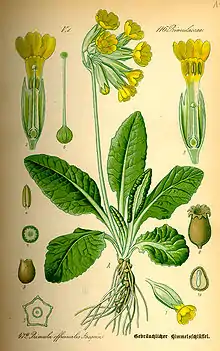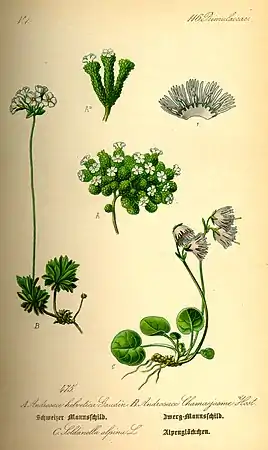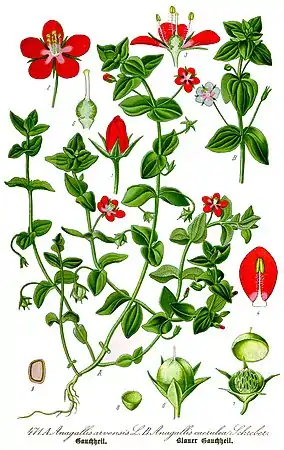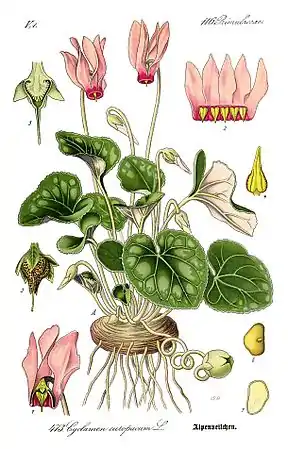Primulaceae
The Primulaceae, commonly known as the primrose family (but not related to the evening primrose family),[3] are a family of herbaceous and woody flowering plants including some favorite garden plants and wildflowers. Most are perennial though some species, such as scarlet pimpernel,[4] are annuals.[5] It includes the former families Myrsinaceae, Theophrastaceae and Maesaceae.
| Primulaceae | |
|---|---|
_-_15.jpg.webp) | |
| Primula vulgaris 'rubra' | |
| Scientific classification | |
| Kingdom: | Plantae |
| Clade: | Tracheophytes |
| Clade: | Angiosperms |
| Clade: | Eudicots |
| Clade: | Asterids |
| Order: | Ericales |
| Family: | Primulaceae Batsch ex Borkh., nom. cons.[1] |
| Synonyms[2] | |
| |
Taxonomy
Primulaceae is one of 22 families in the order Ericales.
Formerly, this order included some closely related families: Myrsinaceae (myrsine family), Theophrastaceae, and Maesaceae (which contained only one genus, Maesa). However, morphological and molecular data strongly support their membership in the primuloid clade, which corresponds to the Primulales order in the 1981 Cronquist system.
The four families have been re-circumscribed into a more broadly defined family referred to as Primulaceae sensu lato (s.l.) The two uniting features of this clade are a free central placenta and one stamen opposite each of the corolla lobes.[1][6][7] Below is a proposed cladogram for Primulaceae s.l., formerly Primulales, based on genetic analyses. The names on the branches correspond to the older family definitions.[6][8]
| Primulaceae s.l. |
| |||||||||||||||||||||||||||
In 2016, the primulacae were estimated to include 53 genera and 2790 species,[9] but as of 2017 there were 55 accepted genera:[2]
- Aegiceras Gaertn.
- Amblyanthopsis Mez
- Amblyanthus A.DC.
- Androsace L.
- Antistrophe A.DC.
- Ardisia Sw.
- Ardisiandra Hook. f.
- Badula Juss.
- Bonellia
- Bryocarpum Hook. f. & Thomson
- Clavija
- Conandrium (K.Schumann) Mez
- Coris L.
- Ctenardisia
- Cybianthus Mart.
- Cyclamen L.
- Deherainia
- Dionysia Fenzl
- Discocalyx Mez
- Elingamita G.T.S. Baylis
- Embelia Burm.f.
- Emblemantha B.C.Stone
- Fittingia Mez
- Geissanthus Bentham & Hooker
- Heberdenia Banks ex A.DC.
- Hottonia Boehr. ex L.
- Hymenandra A.DC.
- Jacquinia L.
- Kaufmannia Regel
- Labisia Lindley
- Loheria Merrill
- Lysimachia Tourn. ex L.
- Maesa Forssk.
- Mangenotiella M.Schmid
- Microconomorpha (Mez) Lundell
- Monoporus A.DC.
- Myrsine L.
- Neomezia Votsch
- Omphalogramma Franch.
- Oncostemum A. de Jussieu
- Parathesis J.D.Hooker f.
- Pleiomeris A.DC.
- Primula L.
- Sadiria Mez
- Samolus L.
- Soldanella L.
- Solonia Urban
- Stimpsonia C.Wright ex A.Gray
- Stylogyne A.DC.
- Systellantha B.C.Stone
- Tapeinosperma Hook.f.
- Theophrasta L.
- Trientalis L.
- Vegaea Urban
- Votschia B.Ståhl
- Wallenia Sw.
Description

Stems
Primulaceae are mostly herbaceous, having no woody stem, except that some form cushions (spreading mats a few inches high) and their stems are stiffened by lignin. The stems can grow upright (erect) or spread out horizontally and then turn upright (decumbent).[11][12]
Leaves
Leaves are simple, being directly attached to the stem by a petiole (stalk), but unlike the leaves of most flowering plants they have no stipules. The petiole is short or the leaf tapers gradually towards the base. Leaf arrangement is typically alternate but some are opposite or whorled, and there is generally a rosette at the base of the stem. The edges are toothed (dentate) or sawtoothed. New leaves in the bud are usually involute (rolled towards the upper surface) or conduplicate (folded upwards), but a few species roll downwards.[11][12]
Flowers
Each flower is bisexual, having both stamens and carpels. They have radial symmetry; the petals can be separate or partially or fully fused together to form a tube-shaped corolla that opens up at the mouth to form a bell-like shape (as in item 8 in the figure) or a flat-faced flower. In most of the families of Ericales, stamens alternate with lobes, but in Primulaceae there is a stamen opposite each petal.[8]
The calyx has 4 to 9 lobes and persists after flowering.[12] They are grouped in unbranched, indeterminate clusters such as racemes, spikes, corymbs or umbels.[11]
Reproductive anatomy
The fruit of Primulaceae begins as an ovary and inside it are the future seeds (ovules). These are attached to a central axis without any partitions between them (an arrangement called free central placentation; see item 7 in the figure), and they are bitegmic (having a double protective layer around each ovule). Unlike in most other families of Ericales, both layers form the opening at the top (the micropyle).[8]
Seeds and fruit
As seeds develop, an endosperm grows around the embryo through free division of nuclei without forming walls (nuclear endosperm formation). The embryo forms a pair of short, narrow cotyledons (item 10 in the figure).[11] Usually multiple seeds are in a capsule that is carried on a straight stalk (pedicel or scape). After it matures, it splits apart, releasing the seeds ballistically.[11]
Cultivation
The British National Collection of Double Primroses is held at Glebe Garden, at North Petherwin, in North Cornwall.[13][14][15]
Examples

 Soldanella alpina, Androsace helvetica & Androsace chamaejasme
Soldanella alpina, Androsace helvetica & Androsace chamaejasme


References
- The Angiosperm Phylogeny Group; Chase, M. W.; Christenhusz, J. M.; Fay, M. F.; Byng, J. W.; Judd, W. S.; Soltis, D. E.; Mabberley, D. J.; Sennikov, A. N.; Soltis, P. S.; Stevens, P. R. (May 2016). "An update of the Angiosperm Phylogeny Group classification for the orders and families of flowering plants: APG IV". Botanical Journal of the Linnean Society. 181 (1): 1–20. doi:10.1111/boj.12385.
- "Primulaceae Batsch ex Borkh". Plants of the World Online. Royal Botanic Gardens, Kew. Retrieved 28 April 2019.
- Elpel, Thomas J. "Primulaceae: Primrose Family. Identify plants and flowers". Wildflowers-and-Weeds.com. Retrieved 28 April 2019.
- "Primulaceae". University of California, Davis. Archived from the original on 31 August 2014. Retrieved 28 September 2012.
- "Primulaceae - Primrose Family". PlantLife.org. Archived from the original on 11 May 2013. Retrieved 28 September 2012.
- Soltis, Douglas; Soltis, Pamela; Endress, Peter; Chase, Mark W.; Manchester, Steven; Judd, Walter; Majure, Lucas; Mavrodiev, Evgeny (2018). Phylogeny and evolution of the angiosperms (Revised and updated ed.). University of Chicago Press. pp. 266, 269–271. ISBN 9780226441757.
- "An update of the Angiosperm Phylogeny Group classification for the orders and families of flowering plants: APG III". Botanical Journal of the Linnean Society. 161 (2): 105–121. October 2009. doi:10.1111/j.1095-8339.2009.00996.x.
- Anderberg, A.A.; Rydin, C.; Kallersjo, M. (1 April 2002). "Phylogenetic relationships in the order Ericales s.l.: Analyses of molecular data from five genes from the plastid and mitochondrial genomes". American Journal of Botany. 89 (4): 677–687. doi:10.3732/ajb.89.4.677. PMID 21665668.
- Christenhusz, M.J.M.; Byng, J.W. (2016). "The number of known plants species in the world and its annual increase". Phytotaxa. 261 (3): 201–217. doi:10.11646/phytotaxa.261.3.1.
- Thomé, Otto Wilhelm (1903). Flora von Deutschland, Österreich und der Schweiz. Gera, Zezschwitz. pp. 23, plate 472. Retrieved 28 April 2019.
- Anderberg, A. A. (2013). "Primulaceae". In Kubitzki, Klaus (ed.). Flowering plants - Dicotyledons : Celastrales, oxalidales, rosales, cornales, ericales. The Families and Genera of Vascular Plants. 6. Springer Science & Business Media. pp. 313–319. ISBN 9783662072578.
- Xu, Zhenghao; Chang, Le (2017). "2. Primulaceae". Identification and control of common weeds. Volume 3. Springer. pp. 51–82. ISBN 9789811054037.
- "Glebe Garden". Glebe Garden.
- Byfield, Andy (June 2, 2015). "Double primroses: pretty, difficult" – via www.theguardian.com.
- "CORNWALL GARDENS TRUST » Events » Double Primroses (National Primrose Collection) Launceston, PL15 8JX". www.cornwallgardenstrust.org.uk.
Further reading
- Bhattacharyya, Bharati (2005). Systematic botany. Alpha Science International. pp. 216–218. ISBN 9781842652510.
- Datta, Subhash C. (1988). "Primulaceae". Systematic botany. New Age Intl. pp. 387–388. ISBN 9788122400137.
- Källersjö, M.; Bergqvist, G.; Anderberg, A.A. (2000). "Generic realignment in primuloid families of the Ericales s. l.: a phylogenetic analysis based on DNA sequences from three chloroplast genes and morphology". Am. J. Bot. 87 (9): 1325–41. doi:10.2307/2656725. JSTOR 2656725. PMID 10991903.
- Tomlinson, P. Barry (2016). "Primulaceae (Myrinoideae: Myrsinaceae)". The Botany of Mangroves. Cambridge University Press. pp. 302–308. ISBN 9781316790656.
External links
 Media related to Primulaceae at Wikimedia Commons
Media related to Primulaceae at Wikimedia Commons